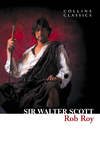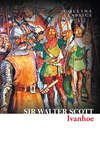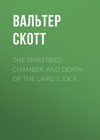Loe raamatut: «Guy Mannering; or, The Astrologer», lehekülg 2
‘The late Madge Gordon was at this time accounted the Queen of the Yetholm clans. She was, we believe, a granddaughter of the celebrated Jean Gordon, and was said to have much resembled her in appearance. The following account of her is extracted from the letter of a friend, who for many years enjoyed frequent and favourable opportunities of observing the characteristic peculiarities of the Yetholm tribes: – “Madge Gordon was descended from the Faas by the mother’s side, and was married to a Young. She was a remarkable personage-of a very commanding presence and high stature, being nearly six feet high. She had a large aquiline nose, penetrating eyes, even in her old age, bushy hair, that hung around her shoulders from beneath a gipsy bonnet of straw, a short cloak of a peculiar fashion, and a long staff nearly as tall as herself. I remember her well; every week she paid my father a visit for her awmous when I was a little boy, and I looked upon Madge with no common degree of awe and terror. When she spoke vehemently (for she made loud complaints) she used to strike her staff upon the floor and throw herself into an attitude which it was impossible to regard with indifference. She used to say that she could bring from the remotest parts of the island friends to revenge her quarrel while she sat motionless in her cottage; and she frequently boasted that there was a time when she was of still more considerable importance, for there were at her wedding fifty saddled asses, and unsaddled asses without number. If Jean Gordon was the prototype of the CHARACTER of Meg Merrilies, I imagine Madge must have sat to the unknown author as the representative of her PERSON.”’[Footnote: Blackwood’s Magazine, vol. I, p. 56.]
How far Blackwood’s ingenious correspondent was right, how far mistaken, in his conjecture the reader has been informed.
To pass to a character of a very different description, Dominie Sampson, – the reader may easily suppose that a poor modest humble scholar who has won his way through the classics, yet has fallen to leeward in the voyage of life, is no uncommon personage in a country where a certain portion of learning is easily attained by those who are willing to suffer hunger and thirst in exchange for acquiring Greek and Latin. But there is a far more exact prototype of the worthy Dominie, upon which is founded the part which he performs in the romance, and which, for certain particular reasons, must be expressed very generally.
Such a preceptor as Mr. Sampson is supposed to have been was actually tutor in the family of a gentleman of considerable property. The young lads, his pupils, grew up and went out in the world, but the tutor continued to reside in the family, no uncommon circumstance in Scotland in former days, where food and shelter were readily afforded to humble friends and dependents. The laird’s predecessors had been imprudent, he himself was passive and unfortunate. Death swept away his sons, whose success in life might have balanced his own bad luck and incapacity. Debts increased and funds diminished, until ruin came. The estate was sold; and the old man was about to remove from the house of his fathers to go he knew not whither, when, like an old piece of furniture, which, left alone in its wonted corner, may hold together for a long while, but breaks to pieces on an attempt to move it, he fell down on his own threshold under a paralytic affection.
The tutor awakened as from a dream. He saw his patron dead, and that his patron’s only remaining child, an elderly woman, now neither graceful nor beautiful, if she ever had been either the one or the other, had by this calamity become a homeless and penniless orphan. He addressed her nearly in the words which Dominie Sampson uses to Miss Bertram, and professed his determination not to leave her. Accordingly, roused to the exercise of talents which had long slumbered, he opened a little school and supported his patron’s child for the rest of her life, treating her with the same humble observance and devoted attention which he had used towards her in the days of her prosperity.
Such is the outline of Dominie Sampson’s real story, in which there is neither romantic incident nor sentimental passion; but which, perhaps, from the rectitude and simplicity of character which it displays, may interest the heart and fill the eye of the reader as irresistibly as if it respected distresses of a more dignified or refined character.
These preliminary notices concerning the tale of Guy Mannering and some of the characters introduced may save the author and reader in the present instance the trouble of writing and perusing a long string of detached notes.
ABBOTSFORD, January, 1829.
ADDENDUM: I may add that the motto of this novel was taken from the Lay of the Last Minstrel, to evade the conclusions of those who began to think that, as the author of Waverley never quoted the works of Sir Walter Scott, he must have reason for doing so, and that the circumstances might argue an identity between them.
ABBOTSFORD, August 1, 1829.
ADDITIONAL NOTE
GALWEGIAN LOCALITIES AND PERSONAGES WHICH HAVE BEEN SUPPOSED TO BE ALLUDED TO IN THE NOVEL
An old English proverb says, that more know Tom Fool than Tom Fool knows; and the influence of the adage seems to extend to works composed under the influence of an idle or foolish planet. Many corresponding circumstances are detected by readers of which the Author did not suspect the existence. He must, however, regard it as a great compliment that, in detailing incidents purely imaginary, he has been so fortunate in approximating reality as to remind his readers of actual occurrences. It is therefore with pleasure he notices some pieces of local history and tradition which have been supposed to coincide with the fictitious persons, incidents, and scenery of Guy Mannering.
The prototype of Dirk Hatteraick is considered as having been a Dutch skipper called Yawkins. This man was well known on the coast of Galloway and Dumfriesshire, as sole proprietor and master of a buckkar, or smuggling lugger, called the ‘Black Prince.’ Being distinguished by his nautical skill and intrepidity, his vessel was frequently freighted, and his own services employed, by French, Dutch, Manx, and Scottish smuggling companies.
A person well known by the name of Buckkar-tea, from having been a noted smuggler of that article, and also by that of Bogle Bush, the place of his residence, assured my kind informant Mr. Train, that he had frequently seen upwards of two hundred Lingtow men assemble at one time, and go off into the interior of the country, fully laden with contraband goods.
In those halcyon days of the free trade, the fixed price for carrying a box of tea or bale of tobacco from the coast of Galloway to Edinburgh was fifteen shillings, and a man with two horses carried four such packages. The trade was entirely destroyed by Mr. Pitt’s celebrated commutation law, which, by reducing the duties upon excisable articles, enabled the lawful dealer to compete with the smuggler. The statute was called in Galloway and Dumfries-shire, by those who had thriven upon the contraband trade, ‘the burning and starving act.’
Sure of such active assistance on shore, Yawkins demeaned himself so boldly that his mere name was a terror to the officers of the revenue. He availed himself of the fears which his presence inspired on one particular night, when, happening to be ashore with a considerable quantity of goods in his sole custody, a strong party of excisemen came down on him. Far from shunning the attack, Yawkins sprung forward, shouting, ‘Come on, my lads; Yawkins is before you.’ The revenue officers were intimidated and relinquished their prize, though defended only by the courage and address of a single man. On his proper element Yawkins was equally successful. On one occasion he was landing his cargo at the Manxman’s Lake near Kirkcudbright, when two revenue cutters (the ‘Pigmy’ and the ‘Dwarf’) hove in sight at once on different tacks, the one coming round by the Isles of Fleet, the other between the point of Rueberry and the Muckle Ron. The dauntless freetrader instantly weighed anchor and bore down right between the luggers, so close that he tossed his hat on the deck of the one and his wig on that of the other, hoisted a cask to his maintop, to show his occupation, and bore away under an extraordinary pressure of canvass, without receiving injury. To account for these and other hairbreadth escapes, popular superstition alleged that Yawkins insured his celebrated buckkar by compounding with the devil for one-tenth of his crew every voyage. How they arranged the separation of the stock and tithes is left to our conjecture. The buckkar was perhaps called the ‘Black Prince’ in honour of the formidable insurer.
The ‘Black Prince’ used to discharge her cargo at Luce, Balcarry, and elsewhere on the coast; but her owner’s favourite landing-places were at the entrance of the Dee and the Cree, near the old Castle of Rueberry, about six miles below Kirkcudbright. There is a cave of large dimensions in the vicinity of Rueberry, which, from its being frequently used by Yawkins and his supposed connexion with the smugglers on the shore, is now called Dirk Hatteraick’s Cave. Strangers who visit this place, the scenery of which is highly romantic, are also shown, under the name of the Gauger’s Loup, a tremendous precipice, being the same, it is asserted, from which Kennedy was precipitated.
Meg Merrilies is in Galloway considered as having had her origin in the traditions concerning the celebrated Flora Marshal, one of the royal consorts of Willie Marshal, more commonly called the Caird of Barullion, King of the Gipsies of the Western Lowlands. That potentate was himself deserving of notice from the following peculiarities: – He was born in the parish of Kirkmichael about the year 1671; and, as he died at Kirkcudbright 23d November 1792, he must then have been in the one hundred and twentieth year of his age. It cannot be said that this unusually long lease of existence was noted by any peculiar excellence of conduct or habits of life. Willie had been pressed or enlisted in the army seven times, and had deserted as often; besides three times running away from the naval service. He had been seventeen times lawfully married; and, besides, such a reasonably large share of matrimonial comforts, was, after his hundredth year, the avowed father of four children by less legitimate affections. He subsisted in his extreme old age by a pension from the present Earl of Selkirk’s grandfather. Will Marshal is buried in Kirkcudbright church, where his monument is still shown, decorated with a scutcheon suitably blazoned with two tups’ horns and two cutty spoons.
In his youth he occasionally took an evening walk on the highway, with the purpose of assisting travellers by relieving them of the weight of their purses. On one occasion the Caird of Barullion robbed the Laird of Bargally at a place between Carsphairn and Dalmellington. His purpose was not achieved without a severe struggle, in which the gipsy lost his bonnet, and was obliged to escape, leaving it on the road. A respectable farmer happened to be the next passenger, and, seeing the bonnet, alighted, took it up, and rather imprudently put it on his own head. At this instant Bargally came up with some assistants, and, recognising the bonnet, charged the farmer of Bantoberick with having robbed him, and took him into custody. There being some likeness between the parties, Bargally persisted in his charge, and, though the respectability of the farmer’s character was proved or admitted, his trial before the Circuit Court came on accordingly. The fatal bonnet lay on the table of the court. Bargally swore that it was the identical article worn by the man who robbed him; and he and others likewise deponed that they had found the accused on the spot where the crime was committed, with the bonnet on his head. The case looked gloomily for the prisoner, and the opinion of the judge seemed unfavourable. But there was a person in court who knew well both who did and who did not commit the crime. This was the Caird of Barullion, who, thrusting himself up to the bar near the place where Bargally was standing, suddenly seized on the bonnet, put it on his head, and, looking the Laird full in the face, asked him, with a voice which attracted the attention of the court and crowded audience-’Look at me, sir, and tell me, by the oath you have sworn-Am not _I_ the man who robbed you between Carsphairn and Dalmellington?’ Bargally replied, in great astonishment, ‘By Heaven! you are the very man.’ ‘You see what sort of memory this gentleman has,’ said the volunteer pleader; ‘he swears to the bonnet whatever features are under it. If you yourself, my Lord, will put it on your head, he will be willing to swear that your Lordship was the party who robbed him between Carsphairn and Dalmellington.’ The tenant of Bantoberick was unanimously acquitted; and thus Willie Marshal ingeniously contrived to save an innocent man from danger, without incurring any himself, since Bargally’s evidence must have seemed to every one too fluctuating to be relied upon.
While the King of the Gipsies was thus laudably occupied, his royal consort, Flora, contrived, it is said, to steal the hood from the judge’s gown; for which offence, combined with her presumptive guilt as a gipsy, she was banished to New England, whence she never returned.
Now, I cannot grant that the idea of Meg Merrilies was, in the first concoction of the character, derived from Flora Marshal, seeing I have already said she was identified with Jean Gordon, and as I have not the Laird of Bargally’s apology for charging the same fact on two several individuals. Yet I am quite content that Meg should be considered as a representative of her sect and class in general, Flora as well as others.
The other instances in which my Gallovidian readers have obliged me by assigning to
Airy nothing
A local habitation and a name,
shall also be sanctioned so far as the Author may be entitled to do so. I think the facetious Joe Miller records a case pretty much in point; where the keeper of a museum, while showing, as he said, the very sword with which Balaam was about to kill his ass, was interrupted by one of the visitors, who reminded him that Balaam was not possessed of a sword, but only wished for one. ‘True, sir,’ replied the ready-witted cicerone; ‘but this is the very sword he wished for.’ The Author, in application of this story, has only to add that, though ignorant of the coincidence between the fictions of the tale and some real circumstances, he is contented to believe he must unconsciously have thought or dreamed of the last while engaged in the composition of Guy Mannering.
EDITOR’S INTRODUCTION TO GUY MANNERING
The second essay in fiction of an author who has triumphed in his first romance is a doubtful and perilous adventure. The writer is apt to become self-conscious, to remember the advice of his critics, – a fatal error, – and to tremble before the shadow of his own success. He knows that he will have many enemies, that hundreds of people will be ready to find fault and to vow that he is “written out.” Scott was not unacquainted with these apprehensions. After publishing “Marmion” he wrote thus to Lady Abercorn: -
“No one acquires a certain degree of popularity without exciting an equal degree of malevolence among those who, either from rivalship or from the mere wish to pull down what others have set up, are always ready to catch the first occasion to lower the favoured individual to what they call his ‘real standard.’ Of this I have enough of experience, and my political interferences, however useless to my friends, have not failed to make me more than the usual number of enemies. I am therefore bound, in justice to myself and to those whose good opinion has hitherto protected me, not to peril myself too frequently. The naturalists tell us that if you destroy the web which the spider has just made, the insect must spend many days in inactivity till he has assembled within his person the materials necessary to weave another. Now, after writing a work of imagination one feels in nearly the same exhausted state as the spider. I believe no man now alive writes more rapidly than I do (no great recommendation); but I never think of making verses till I have a sufficient stock of poetical ideas to supply them, – I would as soon join the Israelites in Egypt in their heavy task of making bricks without clay. Besides, I know, as a small farmer, that good husbandry consists in not taking the same crop too frequently from the same soil; and as turnips come after wheat, according to the best rules of agriculture, I take it that an edition of Swift will do well after such a scourging crop as ‘Marmiou.’”
[March 13, 1808. Copied from the Collection of Lady Napier and Ettrick.]
These fears of the brave, then, were not unfamiliar to Scott; but he audaciously disregarded all of them in the composition of “Guy Mannering.” He had just spun his web, like the spider of his simile, he had just taken off his intellectual fields the “scourging crop” of “The Lord of the Isles,” he had just received the discouraging news of its comparative failure, when he “buckled to,” achieved “Guy Mannering” in six weeks, and published it. Moliere tells us that he wrote “Les Facheux” in a fortnight; and a French critic adds that it reads indeed as if it had been written in, a fortnight. Perhaps a self-confident censor might venture a similar opinion about “Guy Mannering.” It assuredly shows traces of haste; the plot wanders at its own will; and we may believe that the Author often-did not see his own way out of the wood. But there is little harm in that. “If I do not know what is coming next,” a modern novelist has remarked, “how can the public know?” Curiosity, at least, is likely to be excited by this happy-go-lucky manner of Scott’s. “The worst of it is;” as he wrote to Lady Abercorn about his poems (June 9,1808), “that I am not very good or patient in slow and careful composition; and sometimes I remind myself of the drunken man, who could run long after he could not walk.” Scott could certainly run very well, though averse to a plodding motion.
[He was probably thinking of a famous Edinburgh character, “Singing Jamie Balfour.” Jamie was found very drunk and adhering to the pavement one night. He could not raise himself; but when helped to his feet, ran his preserver a race to the tavern, and won!]
The account of the year’s work which preceded “Guy Mannering” is given by Lockhart, and is astounding. In 1814 Scott had written, Lockhart believes, the greater part of the “Life of Swift,” most of “Waverley” and the “Lord of the Isles;” he had furnished essays to the “Encyclopaedia,” and had edited “The Memorie of the Somervilles.” The spider might well seem spun out, the tilth exhausted. But Scott had a fertility, a spontaneity, of fancy equalled only, if equalled at all, by Alexandre Dumas.
On November 7 of this laborious year, 1814, Scott was writing to Mr. Joseph Train, thanking him for a parcel of legendary lore, including the Galloway tale of the wandering astrologer and a budget of gypsy traditions. Falling in the rich soil of Scott’s imagination, the tale of the astrologer yielded a name and an opening to “Guy Mannering,” while the gypsy lore blossomed into the legend of Meg Merrilies. The seed of the novel was now sown. But between November 11 and December 25 Scott was writing the three last cantos of the “Lord of the Isles.” Yet before the “Lord of the Isles” was published (Jan. 18, 1815), two volumes of “Guy Mannering” were in print (Letter to Morritt, Jan. 17, 1815.) The novel was issued on Feb. 14, 1815. Scott, as he says somewhere, was like the turnspit dog, into whose wheel a hot cinder is dropped to encourage his activity. Scott needed hot cinders in the shape of proof-sheets fresh from the press, and he worked most busily when the printer’s devil was waiting. In this case, not only the printer’s devil, but the wolf was at the door. The affairs of the Ballantynes clamoured for moneys In their necessity and his own, Scott wrote at the rate of a volume in ten days, and for some financial reason published “Guy Mannering” with Messrs. Longmans, not with Constable. Scott was at this moment facing creditors and difficulties as Napoleon faced the armies of the Allies, – present everywhere, everywhere daring and successful. True, his “Lord of the Isles” was a disappointment, as James Ballantyne informed him. “‘Well, James, so be it; but you know we must not droop, for we cannot afford to give over. Since one line has failed, we must just stick to something else.’ And so he dismissed me, and resumed his novel.”
In these circumstances, far from inspiring, was “Guy Mannering” written and hurried through the press. The story has its own history: one can watch the various reminiscences and experiences of life that crystallized together in Scott’s mind, and grouped themselves fantastically into his unpremeditated plot. Sir Walter gives, in the preface of 1829, the legend which he heard from John MacKinlay, his father’s Highland servant, and on which he meant to found a tale more in Hawthorn’s manner than in his own. That plan he changed in the course of printing, “leaving only just enough of astrology to annoy pedantic reviewers and foolish Puritans.” Whence came the rest of the plot, – the tale of the long-lost heir, and so on? The true heir, “kept out of his own,” and returning in disguise, has been a favourite character ever since Homer sang of Odysseus, and probably long before that. But it is just possible that Scott had a certain modern instance in his mind. In turning over the old manuscript diary at Branxholme Park (mentioned in a note to “Waverley”), the Editor lighted on a singular tale, which, in the diarist’s opinion, might have suggested “Guy Mannering” to Sir Walter. The resemblance between the story of Vanbeest Brown and the hero of the diarist was scanty; but in a long letter of Scott’s to Lady Abercorn (May 21, 1813), a the Editor finds Sir Walter telling his correspondent the very narrative recorded in the Branxholme Park diary. Singular things happen, Sir Walter says; and he goes on to describe a case just heard in the court where he is sitting as Clerk of Sessions. Briefly, the anecdote is this: A certain Mr. Carruthers of Dormont had reason to suspect his wife’s fidelity. While proceedings for a divorce were pending, Mrs. Carruthers bore a daughter, of whom her husband, of course, was legally the father. But he did not believe in the relationship, and sent the infant girl to be brought up, in ignorance of her origin and in seclusion, among the Cheviot Hills. Here she somehow learned the facts of her own story. She married a Mr. Routledge, the son of a yeoman, and “compounded” her rights (but not those of her issue) for a small sung of ready money, paid by old Dormont. She bears a boy; then she and her husband died in poverty. Their son was sent by a friend to the East Indies, and was presented with a packet of papers, which he left unopened at a lawyer’s. The young man made a fortune in India, returned to Scotland, and took a shooting in Dumfriesshire, near bormont, his ancestral home. He lodged at a small inn hard by, and the landlady, struck by his name, began to gossip with him about his family history. He knew nothing of the facts which the landlady disclosed, but, impressed by her story, sent for and examined his neglected packet of papers. Then he sought legal opinion, and was advised, by President Blair, that he had a claim worth presenting on the estate of Dormont. “The first decision of the cause,” writes Scott, “was favourable.” The true heir celebrated his legal victory by a dinner-party, and his friends saluted him as “Dormont.” Next morning he was found dead. Such is the true tale. As it occupied Scott’s mind in 1813, and as he wrote “Guy Mannering” in 1814-15, it is not impossible that he may have borrowed his wandering heir, who returns by pure accident to his paternal domains, and there learns his origin at a woman’s lips, from the Dormont case. The resemblance of the stories, at least, was close enough to strike a shrewd observer some seventy years ago.
Another possible source of the plot-a more romantic origin, certainly-is suggested by Mr. Robert Chambers in “Illustrations of the Author of ‘Waverley.’” A Maxwell of Glenormiston, “a religious and bigoted recluse,” sent his only son and heir to a Jesuit College in Flanders, left his estate in his brother’s management, and died. The wicked uncle alleged that the heir was also dead. The child, ignorant of his birth, grew up, ran away from the Jesuits at the age of sixteen, enlisted in the French army, fought at Fontenoy, got his colours, and, later, landed in the Moray Firth as a French officer in 1745. He went through the campaign, was in hiding in Lochaber after Drumossie, and in making for a Galloway port, was seized, and imprisoned in Dumfries. Here an old woman of his father’s household recognized him by “a mark which she remembered on his body.” His cause was taken up by friends; but the usurping uncle died, and Sir Robert Maxwell recovered his estates without a lawsuit. This anecdote is quoted from the “New Monthly Magazine,” June, 1819. There is nothing to prove that Scott was acquainted with this adventure. Scott’s own experience, as usual, supplied him with hints for his characters. The phrase of Dominie Sampson’s father, “Please God, my bairn may live to wag his pow in a pulpit,” was uttered in his own hearing. There was a Bluegown, or Bedesman, like Edie Ochiltree, who had a son at Edinburgh College. Scott was kind to the son, the Bluegown asked him to dinner, and at this meal the old man made the remark about the pulpit and the pow.’ A similar tale is told by Scott in the Introduction to “The Antiquary” (1830). As for the good Dominie, Scott remarks that, for “certain particular reasons,” he must say what he has to say about his prototype “very generally.” Mr. Chambers’ finds the prototype in a Mr. James Sanson, tutor in the house of Mr. Thomas Scott, Sir Walter’s uncle. It seems very unlike Sir Walter to mention this excellent man almost by his name, and the tale about his devotion to his patron’s daughter cannot, apparently, be true of Mr. James Sanson. The prototype of Pleydell, according to Sir Walter himself (Journal, June 19, 1830), was “my old friend Adam Rolland, Esq., in external circumstances, but not in frolic or fancy.” Mr. Chambers, however, finds the original in Mr. Andrew Crosbie, an advocate of great talents, who frolicked to ruin, and died in 1785. Scott may have heard tales of this patron of “High Jinks,” but cannot have known him much personally. Dandie Dinmont is simply the typical Border farmer. Mr. Shortreed, Scott’s companion in his Liddesdale raids, thought that Willie Elliot, in Millburnholm, was the great original. Scott did not meet Mr. James Davidson in Hindlee, owner of all the Mustards and Peppers, till some years after the novel was written. “Guy Mannering,” when read to him, sent Mr. Davidson to sleep. “The kind and manly character of Dandie, the gentle and delicious one of his wife,” and the circumstances of their home, were suggested, Lockhart thinks, by Scott’s friend, steward, and amanuensis, Mr. William Laidlaw, by Mrs. Laidlaw, and by their farm among the braes of Yarrow. In truth, the Border was peopled then by Dandies and Ailies: nor is the race even now extinct in Liddesdale and Teviotdale, in Ettrick and Yarrow. As for Mustard and Pepper, their offspring too is powerful in the land, and is the deadly foe of vermin. The curious may consult Mr. Cook’s work on “The Dandie Dinmont Terrier.” The Duke of Buccleugh’s breed still resembles the fine example painted by Gainsborough in his portrait of the duke (of Scott’s time). “Tod Gabbie,” again, as Lockhart says, was studied from Tod Willie, the huntsman of the hills above Loch Skene. As for the Galloway scenery, Scott did not know it well, having only visited “the Kingdom” in 1793, when he was defending the too frolicsome Mr. McNaught, Minister of Girthon. The beautiful and lonely wilds of the Glenkens, in central Galloway, where traditions yet linger, were, unluckily, terra incognita to Scott. A Galloway story of a murder and its detection by the prints of the assassin’s boots inspired the scene where Dirk Hatteraick is traced by similar means. In Colonel Mannering, by the way, the Ettrick Shepherd recognized “Walter Scott, painted by himself.”
The reception of “Guy Mannering” was all that could be wished. William Erskine and Ballantyne were “of opinion that it is much more interesting than ‘Waverley.’” Mr. Morritt (March, 1815) pronounced himself to be “quite charmed with Dandie, Meg Merrilies, and Dirk Hatteraick, – characters as original as true to nature, and as forcibly conceived as, I had almost said, could have been drawn by Shakspeare himself.” The public were not less appreciative. Two thousand copies, at a guinea, were sold the day after publication, and three thousand more were disposed of in three months. The professional critics acted just as Scott, speaking in general terms, had prophesied that they would. Let us quote the “British Critic” (1815).
“There are few spectacles in the literary world more lamentable than to view a successful author, in his second appearance before the public, limping lamely after himself, and treading tediously and awkwardly in the very same round, which, in his first effort, he had traced with vivacity and applause. We would not be harsh enough to say that the Author of ‘Waverley’ is in this predicament, but we are most unwillingly compelled to assert that the second effort falls far below the standard of the first. In ‘Waverley’ there was brilliancy of genius… In ‘Guy Mannering’ there is little else beyond the wild sallies of an original genius, the bold and irregular efforts of a powerful but an exhausted mind. Time enough has not been allowed him to recruit his resources, both of anecdote and wit; but, encouraged by the credit so justly, bestowed upon one of then most finished portraits ever presented to the world, he has followed up the exhibition with a careless and hurried sketch, which betrays at once the weakness and the strength of its author.
“The character of Dirk Hatteraick is a faithful copy from nature, – it is one of those moral monsters which make us almost ashamed of our kind. Still, amidst the ruffian and murderous brutality of the smuggler, some few feelings of our common nature are thrown in with no less ingenuity than truth… The remainder of the personages are very little above the cast of a common lively novel… The Edinburgh lawyer is perhaps the most original portrait; nor are the saturnalia of the Saturday evenings described without humour. The Dominie is overdrawn and inconsistent; while the young ladies present nothing above par..
“There are parts of this novel which none but one endowed with the sublimity of genius could have dictated; there are others which any ordinary character cobbler might as easily have stitched together. There are sparks both of pathos and of humour, even in the dullest parts, which could be elicited from none but the Author of ‘Waverley.’.. If, indeed, we have spoken in a manner derogatory to this, his later effort, our censure arises only from its comparison with the former..
“We cannot, however, conclude this article without remarking the absurd influence which our Author unquestionably attributes to the calculations of judicial astrology. No power of chance alone could have fulfilled the joint predictions both of Guy Mannering and Meg Merrilies; we cannot suppose that the Author can be endowed with sufficient folly to believe in the influence of planetary conjunctions himself, nor to have so miserable an idea of the understanding of his readers as to suppose them capable of a similar belief. We must also remember that the time of this novel is not in the dark ages, but scarcely forty years since; no aid, therefore, can be derived from the general tendency of popular superstition. What the clew may be to this apparent absurdity, we cannot imagine; whether the Author be in jest or earnest we do not know, and we are willing to suppose in this dilemma that he does not know himself.”
The “Monthly Review” sorrowed, like the “British,” over the encouragement given to the follies of astrology. The “Critical Review” “must lament that ‘Guy Mannering’ is too often written in language unintelligible to all except the Scotch.” The “Critical Monthly” also had scruples about morality. The novel “advocates duelling, encourages a taste for peeping into the future, – a taste by far too prevalent, – and it is not over nice on religious subjects!”




















